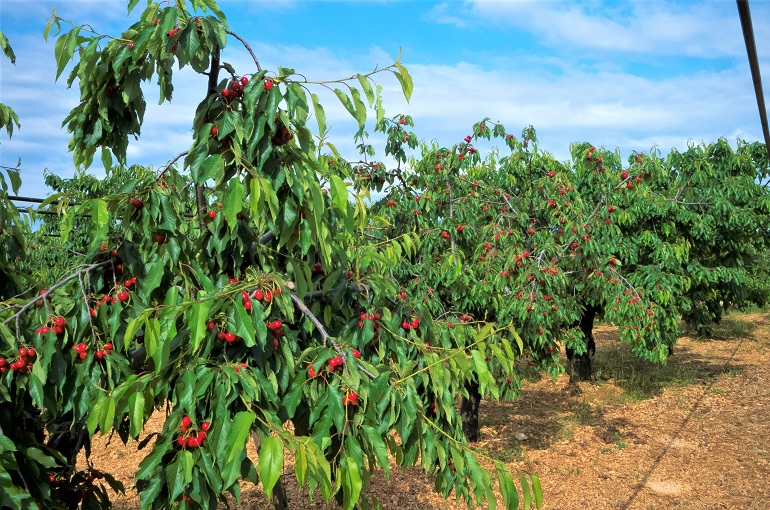Cherry Tree Water Requirements

This post is also available in:
This post is also available in:
![]() Español (Spanish)
Español (Spanish) ![]() Français (French)
Français (French) ![]() Deutsch (German)
Deutsch (German) ![]() Nederlands (Dutch)
Nederlands (Dutch) ![]() हिन्दी (Hindi)
हिन्दी (Hindi) ![]() Türkçe (Turkish)
Türkçe (Turkish) ![]() 简体中文 (Chinese (Simplified))
简体中文 (Chinese (Simplified)) ![]() Ελληνικά (Greek)
Ελληνικά (Greek) ![]() Português (Portuguese (Brazil))
Português (Portuguese (Brazil))
Cherry trees need sufficient water to grow and produce high yields (especially for sweet cherries). It is important to know that regular irrigation during the first year of plant establishment is required in many cases, especially in early spring, during summer, and sometimes during the first months of autumn when the water demand is higher. Cherry trees respond greatly to water supply (in terms of vigorous growth and increased production). Even though mature cherry trees are resilient and can survive droughts, it is sometimes crucial to provide them with adequate water to grow. In areas with insufficient (less than 1 inch or 25.4 mm of rain per week/10 days) or unevenly spread rainfalls during spring, cherry growers may have to start irrigating their orchards from early spring at the start of the flowering stage. Sufficient water supply during fruit formation and enlargement is essential since it promotes the production of larger fruits and reduces the risk of surface pitting in cherries. However, the farmer should stop irrigation 5-7 days before harvest to avoid any losses due to the softness of the fruits (due to excessive water concentration). Even after harvesting, the irrigations may continue (in 3-4 weeks intervals during the warmers-driest summer months). In case there is a drought problem in autumn as well, the irrigation sessions may continue until the start of leaves drop. In general, in very low-density cherry orchards, the average annual irrigation rate is around 1,300 m3 per hectare (520 m3 per acre). On the other hand, when rainfalls are well spread during the growing season and supply cherry trees with sufficient water, there is a limited need for irrigation. In this case, farmers may apply 1-2 irrigation sessions during fruit formation and 1-2 more during the drought summer spells.
Cherry trees are sensitive to excessive soil moisture and root rots. For this reason, growers should adapt the irrigation schedule and the amounts of water added depending on the seasonal needs of the trees (taking into account the soil type, the rainfalls, the age, and the yield of the trees). Using a tensiometer could be useful in forming a suitable irrigation schedule. The methods that are used for watering cherry orchards are basin and furrow irrigation, with drippers and small sprinklers around the trunk of the trees (spray watering). In some states of N. America, farmers noticed that using a double-line drip system could save up to 58% in the water needed. Keep in mind that the tree roots of cherries are quite shallow and well-spread. You can spread the water up to a meter around the trunk but avoid wetting the tree trunk.
As far as sour cherries are concerned, a study showed that woodchip mulch and drip irrigation positively influenced the yielding of young sour cherries. The cultivars „Desertnaya Morozovoi‟, „Latvijas Zemais‟ and „Shokoladnica‟ were significantly more productive in woodchip mulch variant than in other variants due to rash vegetative growth in previous year. Drip irrigation provided even growth and development of spurs, so it advanced the yielding of the cultivars „Bulatnikovskaya‟, „Zentenes‟, „Orlica‟ and„Tamaris‟. The cultivars „Latvijas Zemais‟ and „Orlica‟ were more resistant to twig blight than other cultivars. „Bulatnikovskaya‟ and „Tamaris‟ showed better resistance to cherry leaf spot than others. Drip irrigation slightly improved resistance to cherry leaf spot for the cultivars „Zentenes‟, „Orlica‟ and „Tamaris‟.
References
- https://anrcatalog.ucanr.edu/pdf/2951e.pdf
- https://catalog.extension.oregonstate.edu/sites/catalog/files/project/pdf/pnw642.pdf
- https://u.osu.edu/cfaescapstone/tree-fruits/cherries/care-maintenance/
- https://www.academia.edu/78480804/
Cherries: Info, Facts, Nutritional Value & Health Benefits
Plant Information of cherries
10 Interesting Things About Cherries You Probably Didn’t Know
Growing Cherry Trees for Profit
Soil requirements, preparation, and planting of cherry trees
Cherry Tree Water Requirements
Cherry Tree Propagation and Pollination
Cherry Tree Training, Pruning, and Fruit Thinning
Cherry Tree Fertilization
Cherry Tree Pests and Diseases
Cherries Harvesting and Yield per Hectare – Do you pick cherries with the stem on or off?









































































